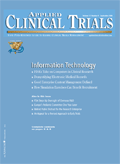Taking Your John Hancock Digital
Applied Clinical Trials
New technology has led to a transition from pens to digital signatures and it is becoming a part of everyday life for the pharmaceutical industry.
With the transition from paper to electronic comes the switch from pens to digital signatures. It's par for the course. But electronic signatures are not new. They've been around for some time. Can you even recall the days when UPS drivers carried around a clipboard and pen? The technology has become a part of everyday life for people and businesses, including the pharmaceutical industry.
Within life science, big pharma was among the early adopters of electronic signature technology. Back then, companies used it for internal applications only, and they were on their own in terms of guidelines for use since FDA had not yet released 21 CFR Part 11--Electronic Records; Electronic Signatures. When final rule did emerge in 1997, compliance became a concern.

Rodd Schlerf, life science practice manager at San Francisco-based ARX, a provider of digital signature and data security solutions, describes compliance efforts as having come in two waves. At first, companies used electronic document management systems like Documentum along with a proprietary digital signature. Eventually, however, they realized their limitations. Explained Schlerf: "These companies said, 'we're creating electronic records but they're proprietary, and the only way we can trust the content is within that system.'"
No good. So, in the second wave, a number of big 10 companies turned to a nonproprietary digital signature solution using a public key infrastructure (PKI) arrangement. This approach supported digital signatures regardless of vendor and document management system. It was an improvement, but in an industry as highly regulated and legalistic as pharma, hurdles still existed.
Then around 2004, some of those top 10 companies that had gone the PKI-route formed the SAFE-BioPharma Association (Fort Lee, NJ). Separate working groups focused on technical, identity management, and proofing standards, in the end creating the SAFE-BioPharma Digital Identity and Signature Standard. Other participants in the effort: FDA's CBER and CDER, and the European Medicines Agency.
"Industry developed SAFE-BioPharma with the view that there would be one individual identity for one person so that you wouldn't have five different digital identities," SAFE's President and Chief Executive Officer Molly Shields-Uehling told Applied Clinical Trials. "And these signatures would be recognized by each other and regulators, and would be enforceable." The "each other" in Shields-Uehling's quote refers to other members of the SAFE Trust community. Right now there are 13 member companies, including Pfizer, J&J, GlaxoSmithKline, and Merck.
There's a fee to join, which starts out at around $6000, and companies must sign a contract agreeing to accept and abide by the rules. In return, members obtain a trusted, digital identity either from SAFE-BioPharma or a vendor that has been certified by them as an "issuer." A number of signing technologies are available to members, including a USB, smart card, and roaming ID that allows signing from anywhere with an Internet connection.
But despite its advantages and that more companies are embracing digital signatures, SAFE-BioPharma hasn't yet attracted a huge following. In 2008's Liquent Regulatory Affairs survey from Thomson Reuters, only two percent of respondents said they were "addressing the SAFE initiative." And while 25% reported plans for implementation, Schlerf—whose company is a SAFE vendor partner—says that outside of large pharma SAFE is not a topic of conversation.
It's not that these companies aren't using trust networks though, they're simply establishing them through vendors like Microsoft and Adobe. However, truer words may not have been spoken than when Shields-Uehling said SAFE-Biopharma is gaining traction considering that both companies are now involved with the nonprofit; Microsoft became a SAFE vendor last year and three of Adobe's products are SAFE certified.
Moving forward, the fact that SAFE-BioPharma is cross certified with the U.S. Federal Bridge—a gateway for exchanging documents with government—should help it gain more traction. Schlerf believes the FDA Gateway will eventually be "the" path for electronic submissions, and the Liquent survey revealed a 10% jump from last year in companies using technology to support it. Good thing since a deadline for going fully electronic is coming, predicts Shields-Uehling. —Kerri Nelen

Behind the Buzz: Why Clinical Research Leaders Flock to SCOPE Summit
February 7th 2025In this episode, we meet with Micah Lieberman, Executive Conference Director for SCOPE Summit (Summit for Clinical Ops Executives) at Cambridge Innovation Institute. We will dive deep into the critical role of collaboration within the clinical research ecosystem. How do we bring together diverse stakeholders—sponsors, CROs, clinical trial tech innovators, suppliers, patients, sites, advocacy organizations, investors, and non-profits—to share best practices in trial design, program planning, innovation, and clinical operations? We’ll explore why it’s vital for thought leaders to step beyond their own organizations and learn from others, exchanging ideas that drive advancements in clinical research. Additionally, we’ll discuss the pivotal role of scientific conferences like SCOPE Summit in fostering these essential connections and collaborations, helping shape the future of clinical trials. Join us as we uncover how collective wisdom and cross-industry partnerships are transforming the landscape of clinical research.
Reaching Diverse Patient Populations With Personalized Treatment Methods
January 20th 2025Daejin Abidoye, head of solid tumors, oncology development, AbbVie, discusses a number of topics around diversity in clinical research including industry’s greatest challenges in reaching diverse patient populations, personalized treatment methods, recruitment strategies, and more.
Phase III Trial Data Show Subcutaneous Pembrolizumab as Noninferior to IV Keytruda
March 31st 2025Subcutaneous administration of pembrolizumab with chemotherapy demonstrated a nearly 50% reduction in patient chair and treatment room time while maintaining efficacy and safety endpoints compared to intravenous Keytruda.
Phase II ALPACA Trial Shows Lepodisiran Produces Significant, Sustained Lipoprotein(a) Reductions
March 31st 2025Eli Lilly’s lepodisiran, an investigational siRNA therapy, achieved significant and durable reductions in lipoprotein(a) levels, a major genetic risk factor for cardiovascular disease.